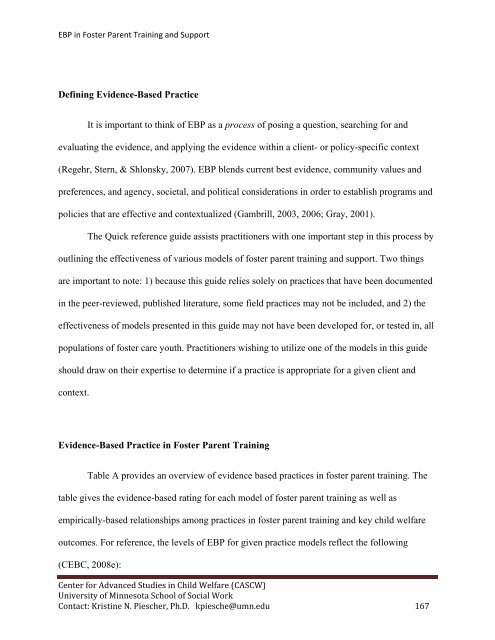Evidence-Based Practice in Foster Parent Training and Support ...
Evidence-Based Practice in Foster Parent Training and Support ...
Evidence-Based Practice in Foster Parent Training and Support ...
You also want an ePaper? Increase the reach of your titles
YUMPU automatically turns print PDFs into web optimized ePapers that Google loves.
EBP <strong>in</strong> <strong>Foster</strong> <strong>Parent</strong> Tra<strong>in</strong><strong>in</strong>g <strong>and</strong> <strong>Support</strong>Def<strong>in</strong><strong>in</strong>g <strong>Evidence</strong>-<strong>Based</strong> <strong>Practice</strong>It is important to th<strong>in</strong>k of EBP as a process of pos<strong>in</strong>g a question, search<strong>in</strong>g for <strong>and</strong>evaluat<strong>in</strong>g the evidence, <strong>and</strong> apply<strong>in</strong>g the evidence with<strong>in</strong> a client- or policy-specific context(Regehr, Stern, & Shlonsky, 2007). EBP blends current best evidence, community values <strong>and</strong>preferences, <strong>and</strong> agency, societal, <strong>and</strong> political considerations <strong>in</strong> order to establish programs <strong>and</strong>policies that are effective <strong>and</strong> contextualized (Gambrill, 2003, 2006; Gray, 2001).The Quick reference guide assists practitioners with one important step <strong>in</strong> this process byoutl<strong>in</strong><strong>in</strong>g the effectiveness of various models of foster parent tra<strong>in</strong><strong>in</strong>g <strong>and</strong> support. Two th<strong>in</strong>gsare important to note: 1) because this guide relies solely on practices that have been documented<strong>in</strong> the peer-reviewed, published literature, some field practices may not be <strong>in</strong>cluded, <strong>and</strong> 2) theeffectiveness of models presented <strong>in</strong> this guide may not have been developed for, or tested <strong>in</strong>, allpopulations of foster care youth. Practitioners wish<strong>in</strong>g to utilize one of the models <strong>in</strong> this guideshould draw on their expertise to determ<strong>in</strong>e if a practice is appropriate for a given client <strong>and</strong>context.<strong>Evidence</strong>-<strong>Based</strong> <strong>Practice</strong> <strong>in</strong> <strong>Foster</strong> <strong>Parent</strong> Tra<strong>in</strong><strong>in</strong>gTable A provides an overview of evidence based practices <strong>in</strong> foster parent tra<strong>in</strong><strong>in</strong>g. Thetable gives the evidence-based rat<strong>in</strong>g for each model of foster parent tra<strong>in</strong><strong>in</strong>g as well asempirically-based relationships among practices <strong>in</strong> foster parent tra<strong>in</strong><strong>in</strong>g <strong>and</strong> key child welfareoutcomes. For reference, the levels of EBP for given practice models reflect the follow<strong>in</strong>g(CEBC, 2008e):Center for Advanced Studies <strong>in</strong> Child Welfare (CASCW)University of M<strong>in</strong>nesota School of Social WorkContact: Krist<strong>in</strong>e N. Piescher, Ph.D. kpiesche@umn.edu 167
















